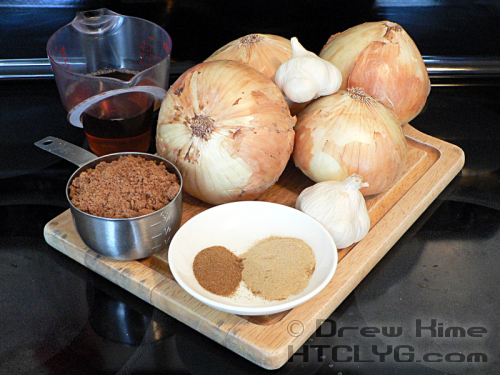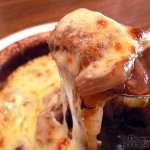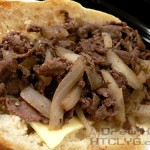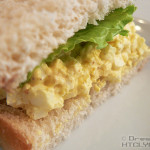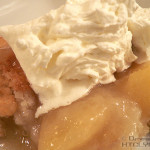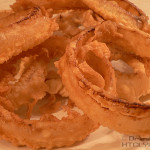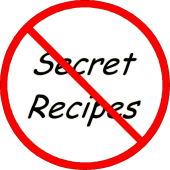Last week my wife was making hamburgers for dinner, and grilled some onions for them. She added a little sugar, something she learned from her father. As I was eating, I thought, “This would be really good on ribs.” I went looking and found a bunch of recipes for onion-based barbecue sauces, but all of them had at least as much tomato paste, ketchup or chile peppers as they had onion. What you see below is the experiment that came from that.
Was the experiment a success? Let’s just say it’s a good thing I made so much of it. My wife is already planning on using it on chicken and pork chops in the next couple of days. It’s just as good for dipping as it is for a glaze.
Ingredients

4 large sweet onions, a little more than 4 pounds (Vidalia are good, I used Texas Sweet this time)
2 whole heads garlic
1 cup brown sugar
1 cup apple cider vinegar
2 teaspoons ground cardamom
1 teaspoon cumin
4 tablespoons rendered bacon fat (see first paragraph below)
salt and pepper to taste
Directions
One great timesaving tip when you cook from scratch is plan meals for the same week where you can prepare part of one meal at the same time you’re doing another. What I did here was to make the sauce for my weekend cookout after I finished cooking the bacon for BLTs. I was going to need some of the bacon fat anyway, and doing it in this order meant I only had to clean that pan once instead of twice.
I could also prep the onions while waiting for the bacon to cook. Since I wasn’t dicing the onions, I did a quicker technique. Slice off the stem and root, set the onion on one of the flat spots you just cut, and slice it in half.
This makes it really easy to peel the outer, papery layer off. Then slice from one side across until the un-cut piece is tall and skinny and wants to tip over when you try to cut it.
Lay this piece down and slice the rest of the way across.
I was able to do all four onions in about two minutes, without even doing that crazy-fast chopping all the TV chefs do to show off. (Although if anyone had been watching, you better believe I would have gone as fast as possible.)
I put the sliced onions in the large pot instead of in a bowl because I was going to be reducing the sauce in that pot after cooking the onion. No reason to dirty an extra bowl if you don’t have to.
Now comes the time saver I mentioned above: the pan I just cooked the bacon in.
I just finished a pound-and-a-half, done in four batches, in the largest stainless steel pan I had. Normally I’d go with either cast iron or non-stick for bacon. But since I was going to be doing the onions, I wanted to get a bit more of the bacon flavor. Besides that, as the onions give up their moisture, it deglazes the pan making it easier to clean. Bonus.
So I set up a little workstation with the frying pan, the onions, and the rendered fat I had just poured out of the pan and filtered. Make sure there is a generous coating of melted fat still in the pan.
You want to use the largest pan you have. The onion caramelizes better when it’s in contact with the surface, so work in batches and don’t crowd it.
While the first batch is sautéing over medium-low heat, peel all the garlic.
Don’t chop, mince or crush the garlic.
Cook the onions, stirring occasionally, until they are dark brown and very soft. Remove the onions, and put the whole garlic cloves in the pan along with another tablespoon of bacon fat. Cook the garlic, shaking the pan frequently, until it is well browned and soft to the touch.
Add the next batch of onion in with the garlic and cook as before, stirring occasionally until the onion is dark brown and very soft.
At this point the onion should already be very sweet. I had my wife taste it and she stood there eating it until I made her stop so I’d have some left for the weekend. She said it was like candy.
Transfer all the onions and garlic to a heavy-bottomed pot.
Since this will be simmering for a while you don’t want the hot spots you get with thin pans, or the onion will burn.
Deglaze the pan with the cider vinegar and add that to the onions.
Using a stick blender, process the onion directly in the pot. If you don’t have a stick blender, you’ll need to do this step in a food processor before returning it to the pot.
You’re done when it’s a smooth, even consistency.
It will look almost like applesauce and, thanks to the cider vinegar, it will even taste surprisingly like applesauce.
Add the cardamom and cumin …
… and the brown sugar …
… and process again until the seasonings are mixed in well. Check the flavor and add salt and pepper as needed. Making this for myself, I’d go very heavy on the black pepper. Since this was going to be for the whole family I left it more mild, maybe only one or two teaspoons. Since I had used a pan that still had the bacon drippings, I only needed about a teaspoon of salt.
Now cover the pot with either a vented lid, or with the lid partially open, over very low heat. The bubbles from this will make a huge mess if you don’t keep something over the pot, but you want the steam to escape. Simmer until the sauce has reduced and thickened. How thick, exactly? Enough to stick to ribs when you put them on the grill. Shoot for the same consistency as whatever store-bough barbecue sauce you usually like.
Compare this to the photo up top where I had just sliced the onions, and you can see how much it cooked down. Transfer the sauce to a sealed container and store in the refrigerator until you use it.
And that’s it.
NOTE: This sauce was made to go on grilled ribs. Subscribe to my feed with the link in the column to the right to see the recipe for that as soon as it comes out. You’ll see it in time to do the cider sweet onion glazed ribs — with the old-fashioned macaroni salad — this weekend.
